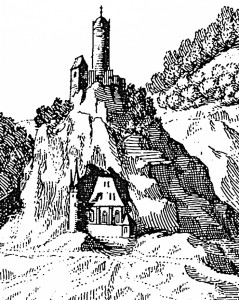
There is one further piece of evidence for the construction of the Felsenkirche in the years 1482/1484. Among the few remnants of the original glazing, one can still see today a portrait of the donator and builder kneeling humbly and the inscription “Wiric vo(n) dune her(r) zu falkenstein und zu(m) oberstein 1482” (“Wirich of Daun, ruler of Falkenstein and of Oberstein 1482). The remaining fragments from the original glazing, which are located today in the “embrasure windows” of the roof ledge, depict the Bishop Nicholas of Myra (with his holy symbol, the three lumps of gold) as well as the coat of arms of the Count of Leiningen (three silver eagles against a blue back-ground), the lineage of the builder’s wife.
The Felsenkirche with the castle (section of a scene by M. Merian, 1654)
